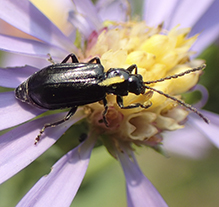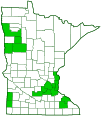black diabrotica
(Diabrotica cristata)
Conservation • Description • Habitat • Ecology • Distribution • Taxonomy
Conservation Status |
|
|||||||
| IUCN Red List | not listed |
|||||||
NatureServe |
NNR - Unranked |
|||||||
| Minnesota | not listed |
|||||||
Description |
||
Black diabrotica is a small cucumber beetle. It occurs in the United States in the northeast from Massachusetts to Maryland, west to North Dakota and Colorado, and south in the Great Plains to Texas. It also occurs in southern Canada from Ontario to Manitoba, and in Mexico. Black diabroticas are generalist feeders. The larvae feed on the roots of many plants, including big bluestem and other grasses, corn, radish, cucumber, lima bean, and plants in the aster (Asteraceae) family. Adults are found from May to September. They feed on the flowers, leaves, stems, and fruit of many plants, including bluestem, brome, panic grass, bristle grass, and goldenrod. The body is elongated oval, ⅛″ to 3⁄16″ (4.1 to 4.7 mm) long, and 1⁄16″ (1.7 to 2.2 mm) wide. When viewed from above, the head and most of the legs are clearly visible. The head is black. It is not pitted (punctate). The antennae are brownish-black, thread-like, and long, about half as long as the body. They have 11 segments. The third segment is short, no more than 1.5 times as long as the second segment. The antennae are close together at the base, about level with the middle of the eyes. They are flexible and can project in various directions. The eyes are not notched. The finger-like process attached to each under jaw (maxillary palp) is black or brownish-black. The exoskeletal plate covering the thorax (pronotum) is squarish, wider than the head, and narrower than the base of the hardened wing covers (elytra). It is usually entirely black, sometimes partly or mostly brownish-orange, rarely entirely orange. The surface is shiny, and smooth, not granular. The sides are shallowly S-shaped. The lateral margins are distinctly flattened. There are two large, deep depressions near the middle. The plate between the wing bases (scutellum) is small, triangular, and black or brownish-black. The elytra are entirely black or brownish-black, hairless, and finely punctate. They are widest at the rear and have a distinct, narrowly flattened margin. Each elytron has a long, deep, sinuous groove. The inner angles of the elytron tips (sutural angles) are rounded. The legs are black or chestnut brown. The last part of each leg (tarsus), corresponding to the foot, has five segments. However, the fourth segment is minute and is concealed within the heart-shaped lobes at the end of the third segment, making it appear that there are only four segments. The last segment has a pair of claws. |
||
Size |
||
Total length: ⅛″ to 2⁄16″ (4.1 to 4.7 mm) |
||
Similar Species |
||
Habitat |
||
|
||
Ecology |
||
Season |
||
May to September |
||
Behavior |
||
|
||
Life Cycle |
||
|
||
Larva Food |
||
Roots of many plants, including big bluestem and other grasses, corn, radish, cucumber, lima bean, and plants in the aster (Asteraceae) family |
||
Adult Food |
||
Flowers, leaves, stems, and fruit of many plants, including bluestem, brome, panic grass, bristle grass, and goldenrod |
||
Distribution |
||||
|
Sources |
|||
| 6/5/2023 | ||||
Occurrence |
||||
|
||||
Taxonomy |
|||
Order |
Coleoptera (Beetles) | ||
Suborder |
Polyphaga (Water, Rove, Scarab, Long-horned, Leaf, and Snout Beetles) | ||
Infraorder |
Cucujiformia | ||
Superfamily |
Chrysomeloidea (leaf beetles and allies) | ||
Family |
Chrysomelidae (leaf beetles) | ||
Subfamily |
Galerucinae (skeletonizing leaf and flea beetles) | ||
Tribe |
Luperini | ||
| Subtribe | Diabroticina | ||
Section |
Diabroticites | ||
| Genus | Diabrotica (cucumber beetles) | ||
Synonyms |
|||
|
|||
Common Names |
|||
black diabrotica crested flea beetle |
|||
Glossary
Elytra
The hardened or leathery forewings of beetles used to protect the fragile hindwings, which are used for flying. Singular: elytron.
Maxillae
Paired mouth structures of arthropods located immediately behind the mandible and used for tasting and manipulating food. “Under-jaws”.
Palp
Short for pedipalp. A segmented, finger-like process of an arthropod; one is attached to each maxilla and two are attached to the labium. They function as sense organs in spiders and insects, and as weapons in scorpions. Plural: palpi or palps.
Pronotum
The exoskeletal plate on the upper side of the first segment of the thorax of an insect.
Punctate
Dotted with pits (punctures), translucent sunken glands, or colored spots of pigment.
Scutellum
The exoskeletal plate covering the rearward (posterior) part of the middle segment of the thorax in some insects. In Coleoptera, Hemiptera, and Homoptera, the dorsal, often triangular plate behind the pronotum and between the bases of the front wings. In Diptera, the exoskeletal plate between the abdomen and the thorax.
Tarsus
On insects, the last two to five subdivisions of the leg, attached to the tibia; the foot. On spiders, the last segment of the leg. Plural: tarsi.
Visitor Photos |
|||||
Share your photo of this insect. |
|||||
| This button not working for you? Simply email us at info@MinnesotaSeasons.com. Attach one or more photos and, if you like, a caption. |
|||||
Babette Kis |
|||||
Diabrotica cristata cucumber beetle Diabrotica cristata, small (abt. 5 mm) brown cucumber beetle on smooth aster. |
 |
||||
MinnesotaSeasons.com Photos |
|||||
|
|||||

Slideshows |
||

Visitor Videos |
|||
Share your video of this insect. |
|||
| This button not working for you? Simply email us at info@MinnesotaSeasons.com. Attach a video, a YouTube link, or a cloud storage link. |
|||
Other Videos |
|||
| The Unique Behavior of Diabrotica cristata Perangai Haiwan |
|||
About
May 31, 2020 Name: Nur Afiqah Izati Bt Mohd Azali |
|||


Created: 6/5/2023
Last Updated:

